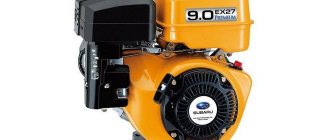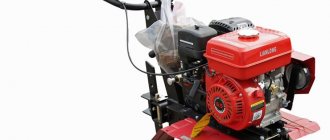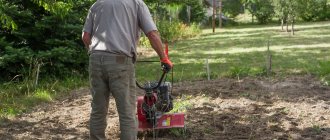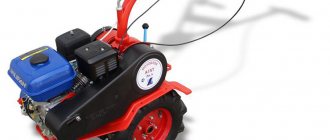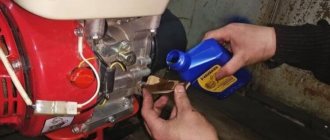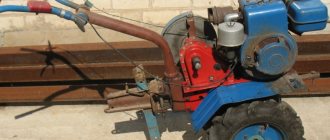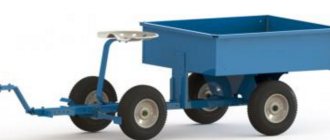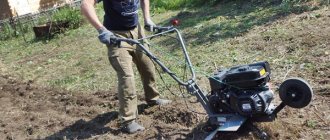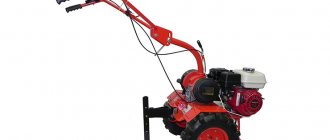Running in a walk-behind tractor is a very important event, without which you cannot start working with this type of equipment. Otherwise, numerous breakdowns and other problems cannot be excluded that can shorten the service life of an expensive device. Experts say that it is impossible to do without running in the walk-behind tractor. But such work should be carried out very carefully. There are certain rules for how to run-in. You should start with a thorough inspection of the equipment, since malfunctions can lead to the fact that even during the first trip the cultivator simply breaks down, and in the future its repair will be very expensive.
Instructions for running in and operating a 4-stroke engine
The first reason for the breakdown: the fuel valve is not closed.
When the engine is not running and the fuel valve is open, the carburetor overflows and the spark plug floods. Gasoline also gets into the engine crankcase. And this will lead to excess pressure during engine operation and squeezing out the seals. Then this mixture of gasoline and oil will enter the combustion chamber and through the exhaust valve into the muffler. Gradually, the muffler will become clogged with oil residues and the engine will lose traction.
ALWAYS CLOSE THE FUEL VALVE AFTER WORK.
First: what kind of gasoline should be used.
We recommend using clean, fresh, unleaded gasoline with an octane rating of AI92. Air-cooled engines are not designed to operate with AI95 and AI98 fuels. 95 and 98 gasoline contain additives that have a detrimental effect on the engine piston system, leading to overheating and breakdown.
Do not mix oil with gasoline. This may result in engine malfunction that is not covered by the warranty.
USE FRESH AI-92 GASOLINE WITH A STORAGE LIFE OF NO MORE THAN 30 DAYS.
How to break in
It is mandatory to break in the walk-behind tractor. This point is not only important, but also key. The further service life of the engine and other equipment depends on this event. Under no circumstances should you add fuel and immediately start the engine - this can cause it to burn out. The device may be used after it has been properly run-in. This action is considered an automotive and engineering term. During break-in, all gear pairs located in the gearbox are ground in.
Everything must be done according to the instruction manual. It indicates the permissible loads for a specific device. Failure to follow basic rules can lead to premature failure. If the function of the walk-behind tractor is to plow soil up to 50 cm deep, then the action is carried out at 30 cm and only on virgin soil. Break-in time depends on the specific device. Some engines are sold with oil filled, others are sold dry. This point must be taken into account. Particular attention is paid to machine oil.
It is important to determine which engine will be used. The hint is on the labels and stickers that come with it. When the oil is poured into the crankcase, you can begin running-in. If it is not there and there are no prompts on the engine, you need to pull out the dipstick and check for the presence/absence of lubricant. If there is oil, you need to start running it in; if not, fill it up.
If difficulties arise, it is recommended to unscrew the oil drain bolt and check for oil.
It's a simple action. If lubricant is present, it will flow immediately. In this case, it is recommended to drain it and fill with new oil. When running in a motor cultivator, you should not accelerate it - this can lead to unpleasant consequences. It is not recommended to torture the technique; the procedure is carried out slowly and carefully.
Beginning of work
Without running in the walk-behind tractor, you absolutely cannot start using it fully. Those who do otherwise almost inevitably encounter a lot of deformation and damage. Also, the unit may become unstable if it is not previously run in. And worst of all, premature failure of the device is likely. This is the right path to expensive repairs or even replacement of a problematic device.
It is important to understand that preparation for work is no less important than the operation itself. If you try to break in a walk-behind tractor in violation of the rules, in an illiterate manner, then it breaks down in almost 100% of cases. Then the necessary repairs turn out to be even more expensive. It is important to take into account that if a major overhaul has been carried out, the device and its engine will have to be run in again. Without this, there is no point in thinking that the walk-behind tractor will work properly for a long time.
Why do you need a break-in?
Engine break-in is an important procedure. As mentioned above, it allows you to extend the service life. This must be done not only when purchasing a new element, but also after a major overhaul of the old one. Before the procedure, you should check the fastening of all bolts. They must be fixed, and the walk-behind tractor itself must be filled with gasoline, lubricant and coolant.
During operation, it is necessary to check the functionality of the brake and steering systems more than once. The steering wheel itself must be in its normal position - this is important. After running-in, the element is inspected and maintenance is carried out. This must be done every 2 thousand hours of operation. All parts must be wiped with diesel oil. The condition of bearings and seals is constantly checked; if they are worn out, they are replaced. The fork and control spring must be reliable. Otherwise problems may arise.
READ How many atmospheres to pump on a walk-behind tractor
All drives and axles must be in perfect condition. If they are worn out, they are replaced immediately. Maintenance is carried out in accordance with the attached operating instructions.
Running in a motor cultivator is one of the most important activities. But before that you need to make preparations. Each part should be lubricated with lubricant according to the manual. Cleanliness must be maintained when adding oil and lubricant.
Transmission oil must be replaced only after the walk-behind tractor has completely stopped. However, it must be drained while hot. Then diesel oil is added and the gearbox is washed. The lubricant must be used in accordance with certain requirements:
- For the walk-behind tractor engine, it is necessary to use transmission oil, preferably TAD-17;
- Semi-synthetic is suitable as a diesel lubricant; it is recommended to use 8AE-30;
- At the same time, synthetic lime grease is used.
All information is provided in the user manual. The further service life depends on the correctness of actions.
Features of the procedure
The first step is to thoroughly check every fastener, every bolt. The tank is filled 100% with gasoline or other necessary fuel or motor oil. You should definitely take care to prepare the coolant in the required volume. Running in does not mean just “grinding” engine parts together, “working” them together. You also need to carefully check the serviceability of the brakes and steering gear.
It is impossible to break in a walk-behind tractor normally if the steering wheel is not positioned according to the rules. After finishing the break-in, you should immediately inspect each part. This takes time, so it is worth carefully planning all the work so that nothing interferes with the process. Technical inspection includes:
studying the condition of each oil seal and bearing;
rubbing them with oil;
immediate replacement of damaged and deformed parts;
checking fork springs and control elements.
How does the walk-behind tractor run in and why is it needed?
Running in a walk-behind tractor is an important undertaking. This will extend its service life and speed it up to perform well. It is impossible to do without running in. Before this procedure, it is necessary to fix all the bolts, fill the walk-behind tractor and create optimal tire pressure.
Sequencing
Running in is grinding in and running in all the parts that are in the engine, transmission and chassis. The action is carried out in a gentle manner for the first 8-10 hours; it is not recommended to rush and work at full capacity. There are 4 basic rules to follow:
- Before each engine start, the oil level must be checked. If necessary, it must be added to the transmission units of the walk-behind tractor.
- The fuel tank must be refilled. In essence, there is nothing complicated about this. However, before carrying out this action, you need to purchase the required brand of fuel with the proper quality.
- At this stage, the cultivator starts. It is advisable to let the engine run at medium speed. Over the next hour, it is necessary to work in all gears in turn. This will allow you to test the functionality of the engine. During this procedure, not only running-in occurs, but also getting used to the operating features of the device.
- After testing all gears, it is necessary to check all the functional features of the device. At this stage it is advisable to cultivate, plow and transport goods. Important: during these actions, the permissible load must be observed.
Every device owner should know how to break in a walk-behind tractor. After all, the further operation of the device depends on this. At the end of the break-in, it is necessary to change the oil in the engine and transmission components. Under no circumstances should the engine be allowed to idle without moving. This is the most common mistake. It can lead to serious problems in the future.
Before work, you must carefully study the instructions. All actions are carried out carefully, according to the described rules. In this case, you don’t have to worry about the further service life.
Approach to different models
You can test the Neva and Plowman in 20 hours. For the Oka walk-behind tractor with a Chinese engine, this period is 30 hours. The most capricious of all are the Zirka blocks - they are run in for at least 50 hours. During this procedure, it is not recommended to immerse the plow or cutter mounted on the Zirka more than 10 cm into the ground. It is important to remember: all walk-behind tractors can only be lubricated with immaculately clean oil, carefully ensuring that it does not become dirty during filling.
When running a walk-behind tractor with a Briggs & Stratton engine, you should definitely change the engine oil every 5-8 hours. If a Honda engine is installed, do not allow it to idle for long periods of time. Otherwise, the accumulation of oil in the crankcase will deprive the lubricant of its beneficial properties. Subaru requires:
monitor the condition of air filters;
evaluate the quality of spark plugs and fuel lines;
Avoid heavy contamination of the cylinder fins.
To learn how to properly break in a walk-behind tractor, watch the video below.
Source
Running in the walk-behind tractor and engine
Many owners of farms, summer cottages and rural plots of land know that without high-quality soil cultivation it is almost impossible to get a good harvest. Using a walk-behind tractor or a walk-behind cultivator facilitates such complex and routine land work as plowing, hilling, planting and harvesting potatoes, making hay and weeding grass. Garden equipment will help not only to carry out land work, but will also cope with the tasks of maintaining the territory, transporting crops, and removing snow in the winter.
We know that any equipment, including our walk-behind tractor, requires careful care and careful operation. For residents of Ukraine, a walk-behind tractor is an expensive purchase, so you cannot immediately start working with it at maximum power. This can lead not only to the failure of individual components, but also to significantly reduce the service life of the entire unit.
The very first and most important process before putting the equipment into operation is running in behind tractor itself. This will help extend the life of the equipment, check the performance of the entire system and reduce the number of failures under high load. We recommend that you first carefully read the operating instructions for your unit model. How to properly break in a walk-behind tractor and engine, read our article.
How long to break in a walk-behind tractor
By referring to the operating instructions for walk-behind tractors of several popular brands, we will take a closer look at the running-in time of the units.
- Neva MB-1, MB-2 and MB-23:
- the first 20 hours of operation of the MB-1 are a break-in period;
- The MB-2 walk-behind tractor of the Neva brand with a Briggs Stratton 6.5 engine is recommended to be run in for the first 25 hours of operation;
- The running-in period for the MB-23 MultiAgro model with a Japanese engine (YAMAHA or Subaru) is 20 hours.
Running in diesel and gasoline engines
Engine running-in is carried out not only after purchasing new equipment, but also when installing a new engine, after major repairs, modernization or replacement of individual components of a walk-behind tractor (motor-cultivator).
Before starting the procedure, it is necessary to check the correctness and quality of assembly of the equipment, the fastening of all connecting bolts, and the presence of the necessary lubricants. The further algorithm of actions is as follows:
- Pour the required amount of oil into the engine crankcase and check its level with a dipstick.
- Add the required amount of fuel to the fuel tank (A92 gasoline or diesel fuel, depending on the engine type).
- Check the connection of the oil level sensor to the relay.
- Open the fuel tank tap.
- Crank the engine manual starter several times without turning on the ignition. On a diesel engine, the decompressor must be turned on.
- Open the air damper of the gasoline carburetor.
- Start the engine and close the throttle as it warms up.
After this, you can begin to break in the engine. At the first stage, it is recommended to start with low speeds, gradually and smoothly increasing them to values slightly above average. In this case, it is necessary to work in all gears of the walk-behind tractor in turn for 1-2 hours. This will make it possible to test not only the engine , but also the gearbox of the unit.
The second stage involves performing cultivation work, plowing the soil and transporting small loads (up to 200 kg). It is very important at this stage not to exceed the permissible load on the walk-behind tractor specified in the operating instructions. Example: if the maximum soil cultivation depth indicated in the passport is 30 cm, then when running in the engine, the immersion depth of the cutter should not exceed 15 cm.
Running in a diesel engine is not fundamentally different from a gasoline engine, but it is important to remember that any engine does not like prolonged idling at high speeds. This is a very common mistake that leads to serious consequences, including major engine repairs. For various walk-behind tractors, the running-in process can take up to 10 engine hours.
READ How much oil is in the gearbox of an oka walk-behind tractor
After running-in of the engine and walk-behind tractor is completed, it is necessary to replace the oil in the crankcase and transmission with a new one , based on the recommendations in the operating instructions.
Firework
The Salyut-100 walk-behind tractor is being run in at medium speeds. The first soil cultivation is carried out with 4 cutters. They are gradually buried lower with each pass. Cultivation is performed with a coulter.
After every 30 minutes of work, take a 10-minute break. After the first 4 hours of operation, the engine oil is changed. The oil in the gear unit is changed after the walk-behind tractor has been run-in.
For this model, 25 hours of running-in of parts is sufficient. During this period, the device must not be turned on at full load. It is also prohibited to overload it with loads during testing.
When running in, strictly adhere to the following standards:
- when testing functional modes, it is necessary to cultivate the area in 2-3 passes, deepening the cutters no more than 10 cm in one pass;
- the throttle valve opens ¾ of its full stroke;
- idle operation of the engine should not exceed 10 minutes;
- check and top up the oil level in the engine.
In the further process of operation, reliability in the operation of the listed models of walk-behind tractors is ensured by systematic maintenance and routine repair work. This necessarily includes changing the oil and transmission fluid.
Oka with Lifan engine
This model must be run in for 30 hours. During this time, all elements are ground in under light operating conditions and defects are identified. The new unit with the Lifan engine must operate at minimal loads during testing.
When testing a walk-behind tractor during functional operations, the following requirements are met:
Engine Lifan 190FD 15hp. First run-in (no load)
- the soil is processed to a depth of 10 cm in one pass in one direction;
- the throttle valve should be open 2/3 of its full travel;
- On clay soil, a walk-behind tractor under load should operate for no more than 2 hours.
In addition, before each start of the engine it is necessary to check the oil level. If there is a shortage, top up to a level above the minimum mark on the dipstick.
This model, like the MB-2 models with other engines, is run in for 20 hours. This time is quite enough for the parts to get used to ideal working condition, and also for defects to appear in them. It is unacceptable to overload the device with a large load during this period.
When running in, the following should be observed:
- cultivate the soil with a full set of cutters in several approaches to a depth of up to 10 cm in one pass;
- load the walk-behind tractor with a load of no more than 200 kg;
- Before starting the engine, check the oil level and, if there is a shortage, top up above the minimum mark on the dipstick;
- refuel the unit with fuel of the required brand and proper quality.
You should also regularly check the drive belt tension. We must not forget about the release element of the left chassis of the walk-behind tractor.
Centaur
A unit of this brand is run in subject to strict rules. Their implementation extends the life of the walk-behind tractor as a whole.
How to test a new engine from Lifan, Loncin, Zongshen and other brands, walk-behind tractors!
Running in the new air-cooled Centaur is carried out according to the following algorithm:
- The motor is loaded in stages: it should work at a third of its technical capabilities in the first three hours.
- After the first three hours of break-in, the engine oil and transmission fluid are drained from the transmission units.
- For the next 4 hours of testing, the engine is loaded to 2/3 of its technical capabilities.
During operation, the permissible loads are monitored. Maintenance and routine repairs are regularly carried out within the time periods allotted by the manufacturer.
How to break in a diesel engine?
There will be no difficulties during break-in if you strictly adhere to the following requirements:
- it is forbidden to sharply increase speed;
- the vehicle speed should be no more than 60–70 kilometers per hour;
- overloading the car is unacceptable;
- after every 2 thousand kilometers you need to change the oil and oil filter;
- it is forbidden to drive at high (more than 3000) speeds;
- starting a “cold” engine is unacceptable (the engine should be warmed up for at least 5 minutes);
- Running in a new diesel engine with a turbine does not allow you to turn off the engine immediately after driving at high speed.
We would like to add that immediately after the engine break-in procedure, a full diagnostic should be performed.
How to break in a walk-behind tractor
Running in a diesel or gasoline walk-behind tractor is grinding in all elements and parts in its system or unit. The process is performed in light load mode for an average of the first 20 hours of machine operation.
For proper running-in, adhere to four points:
- Check the oil level in the engine before starting. If there is a shortage, top up above the minimum dipstick mark.
- Before starting work, the tank is filled with fuel of the brand and quality required by the operating manual.
- Control is carried out to ensure that the engine runs for some time at medium speed. The engine operate in every gear, from first to last.
- During the running-in process, the new walk-behind tractor is tested in functional modes. They carry out cultivation and plowing of the soil, as well as transportation of goods in compliance with the permissible loads specified by the manufacturer.
You should also know: when the walk-behind tractor is in place, it is forbidden to accelerate the engine to full speed.
What rules should you follow?
To properly start a diesel engine unit, you must strictly follow all preparation rules so that the cultivator works for a long time and without failures. For new equipment and past repairs, there is a mandatory general rule: the engine should not be started immediately, simply by refueling. The walk-behind tractor may burn.
Sequencing
Breaking in is grinding in and running in all the parts that are in the engine, transmission and chassis. The action is performed within the first 8-10 hours, it is not recommended to rush and work at full capacity. There are four basic rules:
- Before each engine start, check the oil level. If necessary, it must be added to the engine block transmission unit.
- The fuel tank must be filled with fuel. There is nothing inherently complicated about this. However, before performing this action, you need to purchase the required grade of fuel with the correct quality.
- At this stage the cultivator begins. It is advisable for the engine to operate at medium speed. Over the next hour, you need to work with all the gears one by one. This will allow you to check the functionality of the engine. During this procedure there is not only a bypass, but also dependence on the features of the device.
- After testing all the gears, you need to check all the functionality of the device. At this stage it is advisable to cultivate, plow and transport goods. Important: During these actions you must comply with the permissible load.
READ How to Set the Ignition on an Agro Motoblock
Every device owner should know how to start a walk-behind tractor. In the end, the further operation of the device depends on this. At the end of the break-in, the oil in the engine and transmission units must be changed. Under no circumstances the engine be driven at idle speed without moving. This is the most common mistake. This can lead to
to serious problems in the future.
Read the instructions carefully before starting work. All actions are performed carefully, in accordance with the described rules. In this case, you cannot worry about the further service life.
Owner reviews
Evgeniy : “I’ve been working on the GMS-5.5 cultivator for 2 years now. Initially I liked the compact appearance, which at the same time looks quite impressive. During operation there were no problems, it performs all tasks and does not even overheat. Of the minuses, I noticed that due to the narrow wings, dirt sticks to the engine and interferes with its cooling. It’s bad that the control handle is not adjustable, you have to bend over and fatigue sets in faster.” Maxim : “I almost broke the GMS-5.5 cultivator with my own hands, into which I mistakenly poured kerosene instead of gasoline.
But nothing happened, I cleaned it up and started working. There is not enough power on dense ground, so you have to go through it several times. I didn’t find any drawbacks, except for one thing - there are few dealers who sell attachments, and other manufacturers are not suitable for mounting. Despite the Chinese production, the quality is German!” If you are the owner of a Huter walk-behind tractor, we invite you to leave your review, in which you can familiarize our readers with the advantages and disadvantages of the model.
Lifan engine
Lifan installs several types of engines of different power and modifications on its walk-behind tractors. The most popular diesel walk-behind tractor is the 186FD. However, such a configuration from the manufacturer costs an order of magnitude more, which means that most consumers still choose familiar models with a 4-stroke gasoline engine.
In order to avoid malfunctions of the Lifan engine, you need to carefully monitor its condition and carry out timely maintenance. Let's look at the main parts of the power unit and possible malfunctions of the Lifan engine, as well as ways to eliminate them.
Running in the Lifan walk-behind tractor
Running in the engine of a Lifan allows you to prepare the cultivator for full operation when the equipment is fully loaded. The purpose of running-in is to break in and grind in all elements of the power unit. The process of running in the Lifan is as follows:
- Before starting the engine, check the oil level.
- Fill the fuel tank.
- Start the walk-behind tractor at medium speed.
- For an hour, you need to test the car in all gears one by one.
- Using the cultivator, perform all operations (ploughing, cultivating, transporting cargo) at medium speed and only on previously plowed land.
- After break-in, change the oil and fill the fuel tank.
- The MB is ready to operate at full capacity.
It should be remembered that the break-in process is described in detail in the user manual. Before performing any actions, read the manual and act in accordance with the description.
Description
The Huter brand belongs to the German company HüterElektrischeTechnik GmbH. Since 2011, the concern's production facilities in China have launched the production of a variety of equipment - electric generators, welding and electrical equipment, garden tools, high-pressure washers, lawn mowers, trimmers, electric saws and chainsaws, snowblowers, and motor drills.
Huter motor-cultivators and walk-behind tractors are represented by a small model range - within 10 modifications. Despite the insufficiently extensive dealer and service network, Huter walk-behind tractors are gradually conquering the post-Soviet space.
The equipment is produced under the strict control of German specialists and corresponds to the best European standards, so some marketing shortcomings are successfully covered by the impeccable quality of the machines combined with budget prices.
Maintenance
Maintenance of the Lifan walk-behind tractor includes a number of measures aimed at preserving internal parts and preventing breakdowns, namely:
- Checking the level and changing the oil in the walk-behind tractor engine.
- Checking the level and changing the oil in the walk-behind tractor gearbox.
- Checking, cleaning, replacing the air filter.
- Cleaning the sump.
- Cleaning, adjusting, replacing spark plugs.
- Adjusting valves on a Lifan walk-behind tractor.
- Cleaning the fuel tank.
When performing maintenance, it is important to follow the manufacturer's requirements for the use of fuel and oil. What kind of oil to pour into the walk-behind tractor engine is written in detail in the user manual. If you use the wrong oil or fuel, the walk-behind tractor will malfunction. Maintenance must be carried out in accordance with the schedule in the instructions.
Technical characteristics of Lifan walk-behind tractors
The range of Lifan walk-behind tractors is quite wide. On the market, the company presents new generation cultivators equipped with powerful Lifan engines and having excellent technical characteristics.
Let's look at the technical characteristics using the Lifan 1WG1100С walk-behind tractor as an example:
- Power – 6.5 l. With.
- Engine capacity – 270 cc.
- Engine – Lifan.
- Starting is manual.
- Walk-behind tractor control mode: manual transmission.
- Number of gears – 3.
- Productivity – 0.3 m/s.
- The width of the processed harrow is 800-1100 mm.
- Harrow depth 150-200 mm additional equipment: cutters, wheels.
- Weight – 110 kg.
Engines for the Lifan walk-behind tractor have long established themselves as reliable power units that allow the engine to be used at full power. These engines are installed on both domestic cultivators and imported equipment. The maximum power of the Lifan engine is 6.5 horsepower, which provides the ability to carry out various work on cultivating difficult lands. Today, not only power units are available for sale, but also MB from this company; let’s look at their advantages.
Fuel supply problems
tractor users may encounter . Most often this is not a problem at all.
The fuel supply can be disrupted in two cases: when the tank is empty or when the fuel valve is closed.
The way to fix the problem is to fill the tank and open the valve.
If these measures do not help, you need to clean the air valve or fuel tap; it may be clogged. If these measures do not bring results, you may have filled in with low-quality fuel that should be replaced. If the cause of poor fuel supply is a broken needle valve or carburetor float, repair of these engine parts is necessary.
Stopping the engine
If the Lifan walk-behind tractor suddenly stalls during operation or startup, this may be due to one of three main reasons, namely:
- Malfunction of the ignition system - the ignition timing needs to be adjusted.
- Malfunction in the fuel supply system - identify the cause and eliminate it.
- Compression failure - replace worn parts, adjust clearance or repair valve.
About company
The Huter brand is German, but almost all of its facilities are located in China, which significantly reduces the cost of products and makes them accessible to a wide range of consumers.
Among the products manufactured by the company are walk-behind tractors, lawn mowers, generators, etc. It should be noted that Huter launched the production of walk-behind tractors relatively recently, more precisely in 2011.
They entered the Russian market even later, so the dealer network with service centers has not yet been fully established.
Most of the equipment elements do not coincide with similar units and are not interchangeable. However, thanks to multi-stage control, manufacturers achieve a certain quality of their product, which allows them to operate walk-behind tractors for a long time.
User manual
Before using the MB, it must be assembled and prepared for use. When receiving a cultivator, pay attention to its power unit. It should have a sticker with a safety symbol on it. Latest modifications of the Lifan 8 liter engine. With. Lifan have distinctive features that Honor needs when assembling MB. Modification of the Lifan 900 mm – 1100 mm walk-behind tractor involves the installation of additional equipment to expand the plowed harrow.
When working with a motor cultivator, it is important to observe the following safety precautions:
- Before each start, you should inspect the engine.
- Beware of flammable objects when operating the Lifan engine.
- Keep children and animals away from the operating MB.
- The tank can only be refilled when the MB is turned off.
- Do not start the engine indoors.
Before starting work, each MB must be run-in in accordance with the manufacturer's requirements.
Starting work without running in the Lifan engine entails premature breakdowns and failure of the equipment.
Sources:
https://1sadteh.ru/sovet/obkatka-motobloka.html https://optoweek.com.ua/blog/obkatka-motobloka-i-dvigatelya https://exkavatori-exmash.ru/instrumenty/obkatka-motobloka- kak-pravilno-obkatat-novyj-neva-dvigatel-subaru-dizelnogo.html https://specmahina.ru/motoblok/lifan.html
Types of attachments
The wide range of attachments for Huter walk-behind tractors, which are offered for sale, significantly expands the capabilities of the unit, thereby helping to carry out all the hard work on the farm.
The following types of equipment are suitable for all Hooter models:
- Pump for supplying water to the site;
- Lugs that facilitate the passage of the walk-behind tractor on viscous soil;
- Nozzle for trimming the edges of plantings;
- Mills of various sizes are suitable for cultivating the soil, as well as removing weeds;
- The potato digger is designed for harvesting potatoes by separating the root crop from the ground;
- The harrow helps create furrows, which are subsequently used for planting or watering;
- The hiller is an indispensable device when it is necessary to carry out hilling in rows.
- The adapter and trailer are used to improve operating comfort, as well as for transporting goods.
- Mowers are designed for cutting grass and other grain crops.
- The plow is the most popular device after milling machines, since with its help plowing is carried out faster and more efficiently, especially if the task is to process virgin soil.
- Snow blower, blade-shovel - can be used from other manufacturers, while coping with the job no less effectively. The snow blower throws snow several meters to the side, so you should take safety precautions when working with it.
- The hitch allows you to attach any attachment to the walk-behind tractor.
- Weighting agents are used in those models of walk-behind tractors that are lightweight for effective immersion in the soil.
